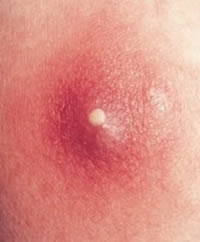
Boils
What is a boil?
Symptoms of boils
Causes of, and risk factors for boils
Dietary improvements to treat boils
Prevention / remedies / cures / treatment for boils
What is a boil?
A boil (also known as a furuncle) is a skin infection that starts in a hair follicle, where pus and dead tissue can accumulate. They start as a small lump less than 2cm (1") in size, and grow into a painful swelling filled with pus. Boils can occur anywhere on the skin, but most often on the back, stomach, underarms, shoulders, face, lips, eyes, nose, thighs and buttocks.

Boils clustered together are called carbuncles. An abscess is also a contained collection of pus, but it can occur anywhere in the body as well as on the skin. However, a boil always originates in a hair follicle.
With a severe infection, a person may have many boils and develop fever and swollen lymph nodes.
If there is a fever, swelling, loss of appetite, rashes, or pain in the chest or elsewhere, consult a health practitioner.
Symptoms of boils
- Red, pus-filled lumps on the skin.
- Tender, painful to touch, hot, inflammed.
- When the boil is ready to drain or discharge pus it has a yellow or white point at the centre.
- Boils sometimes have an unpleasant smell because of the bacteria in the pus or discharge.

Causes of, and risk factors for boils
- Poor hygiene allowing the accumulation of dirt or sweat in a hair follicle, possibly simulated by excessive friction at that point. This allows the outbreak of a bacterial infection (usually Staphylococci).
- Weak immune system, exhausted from fighting other infections or the use of immunosuppressive drugs.
- Malnutrition from poor diet and weak digestion.
- Exposure to chemicals or skin irritants.
- Diabetes mellitus.
- Obesity.
- Acne.
- Eczema.
- Alcoholism. Excessive use of alcohol weakens the liver, digestion (state of nutrition) and immune system.
Dietary improvements to treat boils
- Eat foods rich in vitamin C, such as fresh sour berries, citrus fruits, and fresh, raw sour fruits and vegetables in general.
- Avoid foods containing refined carbohydrates, high sugar levels, and bad oils (omega-6 vegetable and seed oils).
- Eat foods high in vitamin E, such as pine nuts, almonds and other tree nuts, Swiss chard, mustard greens and other leafy greens, avocado, parsley and other herbs.
- Zinc sufficiency.
- Liver-detoxifying foods such as dandelion, artichoke, kelp and other sea vegetables, milk thistle and burdock.
Prevention / remedies / cures / treatment for boils
Boils are a skin infection and may migrate to other parts of the body or be transmitted to other people. Keep towels, clothes and bedding clean and dry, and do not share them (especially towels) as boils are contagious.
Try not to squeeze or lance a boil, as this can spread an infection. A warm compress can help a boil to drain. If a boil head is broken, gently squeeze out the remaining pus, carefully wash, and then use an antiseptic such as colloidal silver, tea tree oil, or fresh garlic, and cover with a clean gauze.
If you use any of these remedies, please come back next week (or whenever you have an outcome) and let us know about your experience. Please leave a comment as many people are interested.
See details of remedies recommended by Grow Youthful visitors, and their experience with them.
In approximate order of effectiveness, Grow Youthful's remedies are:
- Garlic. Make a paste from fresh garlic and apply it to the boil and surrounding red skin. Cover with a clean gauze and leave it on for 15 minutes. Wash with mild soap and water. Repeat 3 or 4 times per day.
- Turmeric. If fresh turmeric is available, slice it finely or pound in a mortar and pestle, and apply to the boil and surrounding red skin. Cover with a gauze or bandage. Leave it on for 30 to 45 minutes. Rinse with clean water and pat dry. Do this twice per day. If fresh turmeric is not available, mix turmeric powder with a little water to make a paste.
- Ginger can be used in a similar manner to turmeric. Even better is a 50-50 mix of ginger and turmeric.
- Apple cider vinegar is a natural disinfectant and anti-inflammatory. Apply a few drops of neat apple cider vinegar to the boil and surrounding skin. If the skin is broken or particularly sensitive, test first.
- Tea tree oil. Wash with mild soap and water, dab dry, and apply a few drops of tea tree oil. Repeat two or three times per day.
- Colloidal silver. Spray or rinse with colloidal silver solution. Wet a gauze with colloidal silver solution and place it over the boil for half an hour.
- Castor oil. Apply a few drops of castor oil to the affected area, cover with a gauze, and leave for a couple of hours. Repeat twice daily. This is a traditional Ayurvedic treatment for boils.
- Salt water. Wash the boil and surrounding skin with mild soap and water, and follow with a rinse of clean water with a little salt added. A teaspoon of salt in a litre (quart) of water is sufficient.
- Onion. Cut an onion into thin slices, and place the slices on the boil and red surrounding skin. Cover with a gauze or clean cloth and leave for a couple of hours.
- Epsom salt (magnesium sulphate). Epsom salt helps bring the boil to a head and then dry it out. It also helps reduce swelling and pain. Stir a teaspoon into three cups of water, and then dampen a clean cloth and leave it on the affected area for 10 to 15 minutes. Repeat 3 or 4 times per day.
